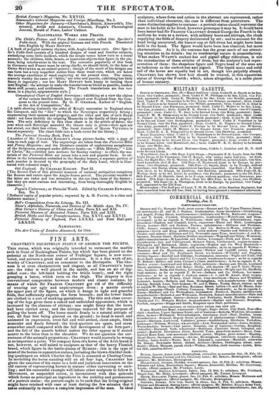FINE ARTS.
CHANTREY'S EQUESTRIAN STATUE OF GEORGE THE FOURTH.
Tars statue, which was originally intended to surmount the marble arch in front of Buckingham Palace, but which has been placed on the pedestal at the North-east corner of Trafalgar Square, is now unco- vered, and attracts a great deal of attention. It is a fine work of art, worthy of CHANTREY, and an ornament to the Metropolis. The like- ness is at once characteristic and elegant, as all CHANTREY'S busts are: the rider is well placed in the saddle, and has an air of dig- nified ease ; the left-hand holding the bridle loosely, and the right grasping a baton, which rests on the thigh. The drapery is that conventional compromise between modern and classic costume, by means of which Sir FRANCIS CHANTREY got rid of the difficulty of treating our ugly and unpicturesque dress : a mantle covers the upper part of the figure, on which it hangs in light and graceful folds, that sufficiently express the form beneath ; and the lower limbs are clothed in a sort of stocking-pantaloons. The thin and close cover- ing of the legs gives them a naked and unfinished appearance, which is increased by the absence of stirrups : one might fancy that the boots bad been carried away, and the stirrups removed for the purpose of pulling the boots off. The horse stands firmly in a natural attitude of rest, all four feet being planted on the ground ; its head is small and animated in expression, crest full and well arched, chest ample, limbs muscular and finely formed : the hind-quarters are spare, and seem somewhat small compared with the full development of the fore-part ; and the fall of the mantle behind makes the rider appear as if seated nearer to the loins than to the shoulder. We do not question the cor- rectness of the animal's proportions : CHANTREY would scarcely be wrong in so important a point. The compact form of a horse of the Arab breed is not, however, so well suited to sculpture as that of the heavy Flemish breed, which figure in the battle-pieces of RUBENS: this is the type of most of the horses in equestrian statues, including the blown-bladder-look- ing quadruped on which Charles the First is mounted at Charing Cross. In modelling the horse standing still on all four legs, CHANTREY has given the sanction of his name to a bold and judicious innovation on the old custom of representing horses in statues either curvetting or amb- ling ; and his successful example will induce other sculptors to follow it. Movement, or suspended action, is inconsistent with that quietude which forms so principal an ingredient in the stability and permanence of a portrait statue : the posture ought to be such that the living original might have retained with ease at least during the few minutes that it takes ordinarily to receive a complete impression of the man. In ideal
sculpture, where form and action in the abstract are represented, rather than individual character, the case is different from portraiture. The same distinction applies to costume : a portrait statue should represent the man in his habit as he lived, however grotesque it may be. It would have been better had Sir Flume CHANTREY dressed George the Fourth in the uniform he wore at a review, with military boots and stirrups, the cloak supplying the folds of drapery desiderated by art ; and to account for the head being uncovered, the hussar-cap or full-dress hat might have been held in the hand. The figure would have been less classical, but more characteristic. As it is, the costume has the great merit of not attract- ing attention to its details ; but its nondescript nature is unsatisfactory. What makes Wirarr's cocked-hat and pigtail effigy ridiculous, is not the introduction of these articles of dress, but the sculptor's bad repre- sentation of them : the shapeless figure and Negro head of the man are as ludicrous as the cocked-hat and pigtail. The liquid mane and solid tail of the horse are equally bad in art, though less palpably absurd. CHANTREY has shown how hair should be treated, in this equestrian statue of George the Fourth; which, taken altogether, is a noble piece of bronze statuary.






























 Previous page
Previous page